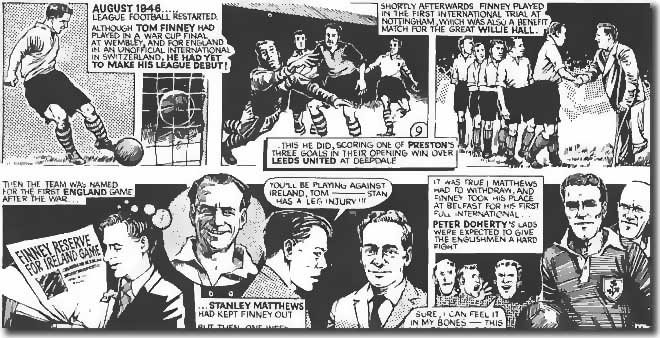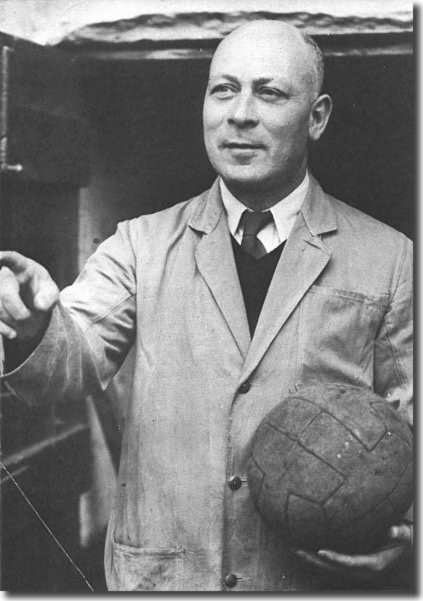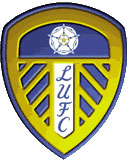|
 If
1945/46 had been disappointing, it had nothing on the season which followed,
one of the most dismal in the entire history of Leeds United. If
1945/46 had been disappointing, it had nothing on the season which followed,
one of the most dismal in the entire history of Leeds United.
Manager Billy Hampson had little
money for new players and relied on those who had served him so well prior
to the war. Les Goldberg, Jim Milburn, Tom Holley, David Cochrane, Gerry
Henry, John Short, Aubrey Powell, George Ainsley, Bobby Browne, Billy
Heaton, Jim Twomey and Ken Gadsby had all been at Elland Road in the Thirties.
A number of other players had arrived during the war, including Tom Hindle,
and Hampson had later brought in new players like winger Dennis Grainger
and half-back Bob Batey, who had played under him at Carlisle. However,
it was noticeable that he did not have much young talent available to
him.
The public's appetite for football was enormous in 1946/47, one of a
handful of pleasures that was not rationed. Had Hampson's team done anything
to encourage their supporters, Elland Road might well have seen record
crowds. But while individual results were less dire than in the previous
season, Leeds United's habit of losing became even worse.
Things started badly from the opening day, although Leeds were involved
in a very historic occasion. Their official post-war record kicked off
on 31 August 1946, with a game away to Preston North End at Deepdale before
more than 25,000 football hungry fans, which marked the Football League
debut of a young winger by the name of Tom Finney, who had already played
for the England side during the war years. Despite two goals from Dennis
Grainger, Leeds United lost 3-2, with Finney marking his big day with
one of the goals.
It very quickly became apparent that Leeds were going to struggle. They
won just three points from the first eight games and by the end of September
were stranded at the foot of the table. They won a couple of games in
October, another two in November and got their first away point on November
30, but that was nowhere near enough and their form started to deteriorate
even further. In fact, they won just 6 games all season, only one between
November 23 and the end of the season and gained just the one point away
from Elland Road. It was frightening stuff and Leeds' ineptitude was astonishing.
Leeds had never been a rich club, but Hampson tried to arrest the decline
by paying out £8,000 to Glentoran for the versatile 23 year old Con Martin
and another £4,000 on  Darlington's
free scoring centre forward Harry Clarke. It cost him rather less to get
Huddersfield's former England half back Ken Willingham in March 1947,
but whatever he did, it made no difference. Leeds were sadly in decline
and were completely out of their depth. Darlington's
free scoring centre forward Harry Clarke. It cost him rather less to get
Huddersfield's former England half back Ken Willingham in March 1947,
but whatever he did, it made no difference. Leeds were sadly in decline
and were completely out of their depth.
After New Year, the team fell apart, winning only one of their last 21
matches - a 2-1 home victory over Chelsea that attracted 37,884, the highest
crowd of the season.
The statistics made grim reading: Leeds' points tally of 18 was the lowest
ever recorded in the First Division and remained so for 38 years. They
were a clear 20 points below the 20th team in the division, they lost
20 of their last 24 games and struggled all season for goals. Their away
record - won 0, drawn 1, lost 20 - uniquely awful.
The writing was on the wall and in April 1947 Hampson was demoted to
chief scout with Leeds already doomed to relegation and loss of the First
Division status they had held since 1932. The board promoted assistant
trainer Willis Edwards, who had
previously played more than 400 times for the club. He took over for the
last six games, all of which ended in defeat.
Paradoxically, the public flocked to Elland Road to see the disaster.
Like most English clubs, Leeds enjoyed an upsurge in crowds following
the war and the average attendance of 26,000 was some 3,000 better than
any previous year.
Other Football Highlights from 1946/47
- After a third of the season the only thing that kept Arsenal off the
bottom of the table was goal average. They lost nine of their first
14 matches and were heading for an unimaginable drop into the Second
Division. Arsenal couldn't find any young players to buy, so they bought
Everton's stalwart 31 year old left-half Joe Mercer for £7,000 and paid
£1,000 plus two reserve players for Ronnie Rooke, Fulham's 35 year old
centre-forward. Rooke got 21 goals in 24 games as Arsenal hauled themselves
clear of trouble
- Nearly a million people flocked to the 43 matches on the opening day
of the season. The season went on to become the longest on record as
a bitter winter played havoc with fixtures. More than 140 matches were
postponed in three months
- The result of the title race hinged on two matches. Wolves, who had
been 11 points clear at one stage, needed to win their last match against
Liverpool to secure the title, but they lost 2-1, which made Liverpool
the new leaders. The Anfield club had to wait a fortnight until June
14 for the result of the Stoke-Sheffield United game to see if they
could hang on as Stoke would win the title on goal average if they won.
Stoke had sold Stanley Matthews to Blackpool for £11,500 in May and
he was badly missed as United won 2-1 to confirm Liverpool's title win
- Stanley Rous, the FA Secretary, appointed chief coach Walter Winterbottom
as the first England football team manager in May 1947, prompting the
national team to beat Portugal 10-0 on May 27
- A Great Britain XI beat the Rest of Europe 6-1 at Hampden in May to
celebrate the home nations rejoining FIFA
- Neil McBain, New Brighton's 52-year-old manager, had to play in goal
in a 3-0 defeat to Hartlepools in the Third Division North when the
club's only regular keeper was injured, thus becoming the oldest player
ever to play in the League
- Derby broke the British transfer record when they paid £15,000 for
Billy Steel of Morton, the Scottish international inside-forward
back to top
|












 If
1945/46 had been disappointing, it had nothing on the season which followed,
one of the most dismal in the entire history of Leeds United.
If
1945/46 had been disappointing, it had nothing on the season which followed,
one of the most dismal in the entire history of Leeds United. Darlington's
free scoring centre forward Harry Clarke. It cost him rather less to get
Huddersfield's former England half back Ken Willingham in March 1947,
but whatever he did, it made no difference. Leeds were sadly in decline
and were completely out of their depth.
Darlington's
free scoring centre forward Harry Clarke. It cost him rather less to get
Huddersfield's former England half back Ken Willingham in March 1947,
but whatever he did, it made no difference. Leeds were sadly in decline
and were completely out of their depth.